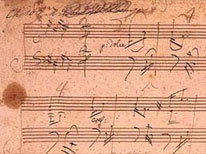About the CollectionsMusic, Theater, Dance: An Illustrated Guide features specialists and curators in the Music Division describing notable items of interest to researchers and important to the intellectual heritage preserved within the Library's walls. The General Collections of the Music DivisionThe general collections of the Music Division consist, broadly speaking, of published musical scores, and books and periodicals on music-related subjects. The Library-assigned call numbers of this material carry the prefixes "M," "ML," or "MT," which provide an idea of their subject matter.
Adhering to the vision of the Music Division's second Chief, Oscar Sonneck (1902-1917), to create a music collection worthy of America's "national library," the Division's general and special collections are, as a result, particularly rich in material related to American music, including manuscripts, correspondence, and papers of every notable American composer, conductor, and musician. Just as much effort, however, has been invested in the development of a collection reflecting a worldwide musical culture. Among its many notable strengths, the Division's general collections include large holdings of opera full scores; the 1909 purchase by the Library of over 12,500 opera libretti from collector Albert Schatz is reputed to be the largest such collection in the world. Predictably, another of the Division's strengths is in the realm of American imprints, dating as far back as the late eighteenth century. These consist in large part of first editions of the sheet music of "popular" songs, including both original compositions (primarily for voice and piano, or for piano solo), and arrangements of what are now considered "classical" works, used primarily by amateur musicians. The Division's collections also include many music pieces registered for copyright in the United States since the inception of federal copyright legislation in 1790. The establishment of a series of copyright laws throughout the nineteenth century (which required that copies of each work published in the United States be deposited with the Library of Congress) has resulted in the unprecedented growth of the collections of the Library as a whole. While important material from all over the world continues to be added to the Library's collections, the material acquired through copyright registration in this country provides a unique perspective on the full spectrum of American scholarship and culture. The Music Division's general collections are no exception in this regard. Under the auspices of the Library's American Memory Project and National Digital Library, full digital images of the earliest copyright deposits held by the Division, dating from between 1870 and 1885, have been created and made available online through the American Memory project homepage. Copyrighted music-related material not selected for addition to the Division's collections may be searched through the COHM database, maintained by the United States Copyright Office, located in the Library of Congress. From its earliest years, the holdings of the Library have included music-related material (the personal library of Thomas Jefferson, purchased by the federal government in 1814 to form the basis of the Congressional Library, included thirteen books about music literature, pedagogy and theory). While the establishment of the Music Division dates only from 1897, it has already witnessed the creation of two Library sections -- the Recorded Sound Section of the Motion Picture, Broadcast, and Recorded Sound Division, and the American Folklife Center -- from subject areas which had originally been developed under the auspices of the Music Division. On the other hand, the Division has acquired reference material to support research in the areas of both theater and dance, as well as some of the primary periodical literature of these two disciplines. As a reflection of a culture's creative impulse, artistic expression continues to evolve as does the society in which it was created. The Music Division is dedicated to exploring new methods and technologies to facilitate the dissemination of information and ideas, both contemporary and historical, from the rich resources contained within its collections. |
| The
Library of Congress >> Especially
for Researchers >> Research
Centers December 15, 2008 |
Contact
Us: Ask a Librarian |
